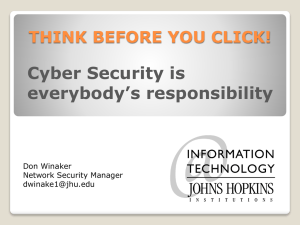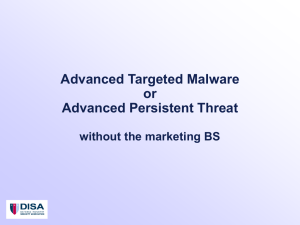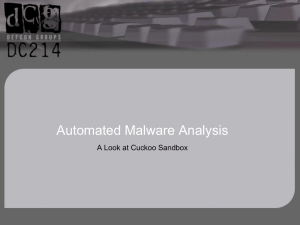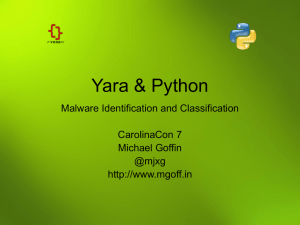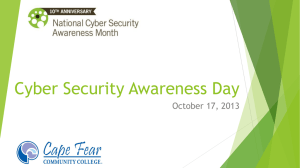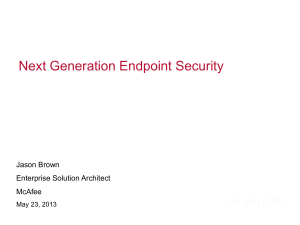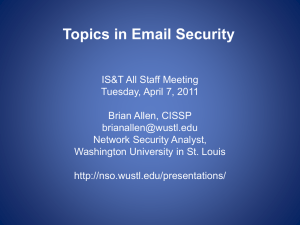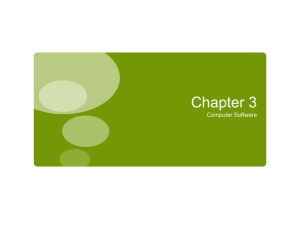Malware - T&T Software WWW Server
advertisement
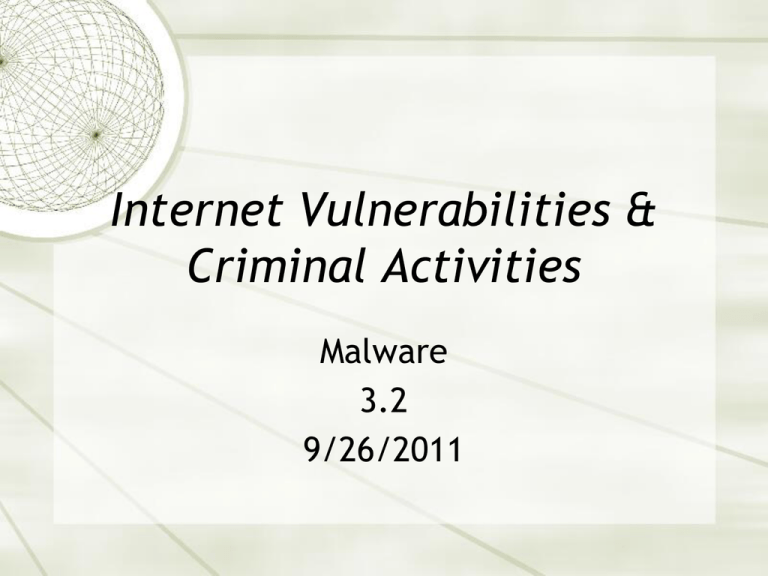
Internet Vulnerabilities & Criminal Activities Malware 3.2 9/26/2011 Malware Malicious software designed to gain access to information and/or resources without the knowledge or consent of the end user Malware History 1981 1983 1986 1988 1990 1991 1994 1995 1998 - First Apple II virus in the wild - Fred Cohen coins term “virus” - First PC virus - Morris Internet worm - First Polymorphic virus - Virus Construction Set - Good Times virus hoax - First Macro Virus - Back Oriface tool released Malware History cont. 1999 - Melissa virus / worm 1999 - Tribal Flood Network - DDOS tool 2001 - Code Red worm 2001 - Nimda worm 2003 - Slammer worm 2004 - So Big & Sasser worms 2007 - Storm worm / Zeus botnet tool 2008 - Conficker worm 2010 – Stuxnet – weaponized malware Malware Trends Increasing complexity & sophistication Acceleration of the rate of release of innovative tools & techniques Movement from viruses to worms to kernel-level exploitations Malware can be: “Proof of concept” Created to prove it can be done Not found outside of laboratory environment If code available, can be used by others “In the Wild.” Found on computers in everyday use Traditional Categories of Malware Virus Worm Malicious Mobile Code Backdoor Trojan Horse Rootkit Combination Malware – Malware “Cocktail” Virus Infects a host file Self replicates Requires human interaction to replicate Examples: Michelangelo Melissa Worm Spreads across a network Does not require human interaction to spread Self-replicating Examples: Morris Worm Code Red Slammer Malicious Mobile Code Lightweight program downloaded from a remote source and executed locally Minimal human interaction Written in Javascript, VBScript, ActiveX, or Java Example: Cross Site Scripting Backdoor Bypasses normal security controls Gives attacker access to user’s system Example: Netcat Back Oriface Sub 7 Trojan Horse Program that disguises its hidden malicious purpose Appears to be harmless game or screensaver Used for spyware & backdoors Not self-replicating Rootkit Replaces or modifies programs thts are part of the operating system Two Levels User-level Kernel-level Examples Universal Rootkit Kernel Intrusion System Combination Malware Uses a combination of various techniques to increase effectiveness Examples: Lion Bugbear.B Stuxnet Malware Distribution Attachments E-mail and Instant Messaging Piggybacking Malware added to legitimate program Adware, spyware EULA - End User License Agreement Internet Worms Exploit security vulnerability Used to install backdoors Web Browser Exploit Malware added to legitimate web site Cross-site scripting & SQL Injection Visitors to web site may be infected Drive by malware Malware Distribution cont. Hacking Too labor intensive for large crime operations May be used to compromise DNS server Affiliate Marketing Web site owner paid 8¢ to 50 ¢ per machine to install malware on a visitor’s computer Mobile Devices Transfer via bluetooth Malware Activity Adware Spyware Hijacker Toolbars Dialers Rogue Security Software Bots Adware Displays ads on infected machine Ads format can be: Pop-ups Pop-under Embedded in programs On top web site ads More annoying than dangerous Spyware Send information about infected computer to someone, somewhere Web sites surfed Terms searched for Information from web forms Files downloaded Search hard drive for files installed E-mail address book Browser history Logon names, passwords, credit card numbers Any other personal information Hijacker Takes control of web browser Home page Search engines Search bar Redirect sites Prevent some sites from loading IE vulnerable Toolbars Plug-ins to IE Google Yahoo Attempt to emulate legitimate toolbars Installed via underhanded means Adware or Spyware Acts a keystroke logger Dialers Alters modem connections and ISDN- Cards Once installed, will dial 1-900 numbers or other premium rate numbers Run up end-users phone bill & provide revenue for criminal enterprise Targets MS Windows Rogue Security Software Usually delivered via a trojan horse Uses social engineering techniques to get user to install Fake warnings that computer is infected Fake video of machine crashing Disables anti-virus and anti-spyware programs Alters computer system so the rogue software cannot be removed Bots Allows attacker remote access to a computer When end-user is online, computer contacts Command & Control (C&C) site Bot will then perform what ever commands received from the C&C Some things botnets are used for Distributed Denial of Service (DDoS) attacks Spam Hosting contraband such as child porn Other illegal fraud schemes Weaponized Malware Attacks SCADA system Supervisory Control And Data Acquisition Causes physical damage SCADA systems control Dams Electrical grid Nuclear power plants Cyber War - The Aurora Project http://www.youtube.com/watch?v=rTkXgqK1l9A More Malware Terminology Downloader Single line of code Payload from malware Instructs infect computer to download malware from attacker’s server Drop Clandestine computer or service (E-mail) Collects information sent to it from infected machines Blind Drop - well hidden, designed to run attended More Malware Terminology cont. Exploit Code used to take advantage of a vulnerability in software code or configuration Form-grabber A program that steal information submitted by a user to a web site Packer Tool used to scramble and compress an .exe file Hides malicious nature of code Makes analysis of program more difficult More Malware Terminology cont. Redirect HTTP feature Used to forward someone from one web page to another Done invisibly with malware Variant Malware produced from the same code base Different enough to require new signature for detection by anti-virus software Malware Sources Malware Can be programmed from scratch Less likely to be detected by anti-malware programs Can be purchased Malware tools Haxdoor, Torpig, Metafisher, Web Attacker Tools offered with other services Access to botnet, drop sites Tools derived from small stable base of existing code Frauds Involving Malware Advertising schemes Pay-per-view Pay-per-click (“Click Fraud”) Pay-per-install Banking fraud Identity theft Spam Denial-of-service attacks DoS extortion Advertising Schemes Pay-per-view Sell advertising space on controlled web sites Command botnet to “view” as many ads as possible May have ads download in the background Fraudulent commissions generated Advertising Schemes cont. Pay-per-click (“”Click Fraud”) Similar to Pay-per-view fraud Bots simulate clicks on ads Between 5% and 35% of all ad commissions may be fraudulent Pay-per-install Commission paid every times advertisers software is installed When installed, notification sent to advertiser Infected machines will be instructed to install advertisers software Banking Fraud Banks are a prime target of malware Malware can allows attacker to empty victim’s bank account Example (September 2009) Rewrite online bank statements on the fly Covers up theft of funds Trojan horse Alters HTML code before browser displays Makes use of “Money Mules” Identity Theft Phishing & key logging Recent increase in malware associated with identity theft Information sent to drop site Spam Bots used to send spam Also show dramatic rise Bots are available for rent for spam purposes Spam sent can also contain malware Denial of Service Attacks Botnet commanded to make requests of a web site Web site may crash due to heavy traffic Legitimate traffic blocked Threat of DoS attack can be used for extortion Bots for rent for DoS attacks Problems for Law Enforcement Anonymity Jurisdiction Attackers know how difficult international law enforcement is Exploit the situation Target victims in one country from another country Have C&C site and drop site located in a third country Use multiple proxies to access C&C site and drop site Money gain quickly funneled through online bank accounts and international money transfers Other Issues Monetary Threshold Must reach a limit before prosecutor will take case May be hard to prove exact amount of money involved Cyber crimes may be considered a non-priority Virtual world emboldens individuals Less fear of getting caught Realization of difficulties in investigating crimes Easy money
